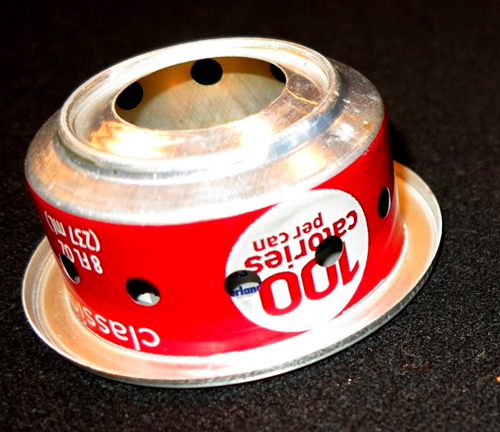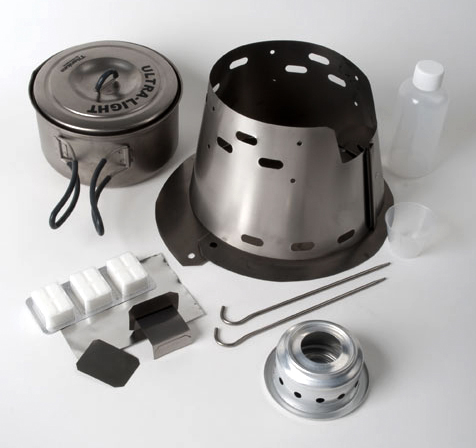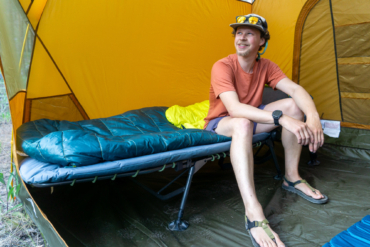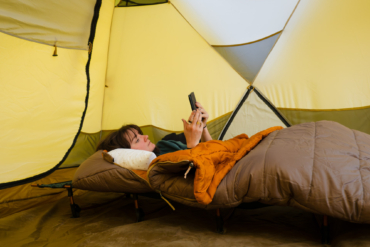By JIM HODGSON
In the quest to make my pack as light as possible for an Appalachian Trail thru-hike, I began researching various ways to throw money at the problem. One recommendation I heard time and again from veteran AT hikers was to ditch my regular camp stove in favor of an alcohol-burning unit made from a Coke can.
Yep, people do actually make stoves out of soda cans. There’s even a mass-produced option from Trail Designs, a company that touts itself as the “finest purveyor of lightweight backpacking gear.”

I found instructions online on how to make my own Coke can stove. But I also know that I tend to get annoyed and sloppy when projects get fiddly, so I gave in and simply purchased my stove from Trail Designs.
It came as a part of the company’s Sidewinder Ti-Tri system, which includes the stove, a titanium cone-stand, and a few extras for $80.
The kit arrived with everything I needed, including a collapsible metal cone designed to simultaneously support my pot and keep the wind from blowing out the stove’s flame. I set off on an overnight shakedown trip to give it a test.

By the time I got to the shelter near the top of a mountain, I was good and hungry. It was eight miles and change to the summit from the parking lot. I dug my pre-packaged meal out of my pack with great anticipation, poured some water into my pot, lit my stove, and waited.
Then I waited some more. Next, I tried waiting a third and fourth time. Some bubbles appeared at the bottom of my pot, but they didn’t seem inclined to turn over into a nice boil. At 20 minutes I felt like giving up.
To use this stove, you first measure fuel with a small measuring cup, then pour that into the stove. Next, assemble the cone-stand by sliding one end into the other. Light the stove, put the cone around it, and put your pot on top. Bam!
Or, not Bam. . . . While I was waiting for my water still to boil, two fellow hikers I’d met on the trek both gathered water, boiled it using their stoves — an MSR Pocket Rocket and a Jetboil — had eaten, and were cleaning up.
I eventually just gave up on my Coke can and poured the warm water into my food. It worked just fine, and I ended up getting to eat a warm, but not piping hot, meal.

Since that first trip I’ve been out on the trail again with the Ti-Tri a couple times and with similar results. Users of other stoves — particularly the Jetboil, I find — are able to boil water in what seems like no time at all. I just stand around and hungrily eyeball my pot.
The can-stove system is certainly light and packs small. Everything fits into my 900ml pot, including a lighter, a measuring cup for fuel, small fuel bottle, the stove base and cone/stand, and a handful of Esbit tablets in case I get caught without any liquid fuel. All of that weighs in at around 13oz.
But that weight compares with the Jetboil Zip system, which hits the 12oz. mark without a fuel canister. (Canister adds around 7oz.) Jetboil’s more pricey SOL TI stove is just 8.5 ounces, and MSR’s Pocket Rocket is just 3 oz. (without canister).
Honestly, the Coke can solution, when you include the cone/stand and the other needed extras, is not that much lighter than these “normal” camp stoves my backpacking buddies had told me to ditch. I could get a lighter pot, and that’d make my package a bit more airy, though we’re squabbling on a few ounces here that may or may not be noticeable in my backpack.
That said, I acknowledge some of my problems with the stove may have amounted to some user error. For example, I bought too big of a pot to start with. One person usually doesn’t need 900ml of water; 400ml would have been more than adequate. Every little bit of water adds more time to get boiling.
I was using denatured alcohol, which burns nearly invisibly. Once the stove is lit, it’s hard to know whether it is going or not without sticking your hand near it, which is a bit like checking whether a snarling dog will bite by giving him a kiss. The stove also burns silently, so if it goes out under your pot you’ll get no indication except a lack of forming bubbles in your pot, which might be tough to spot.
The can stoves use a wide range of flammable liquids, from gas to alcohol, which makes finding fuel easier. You can use Esbit tablets or even plain old wood with the cone unit to boil water without the stove. In contrast, the pressurized canisters used on the Jetboil and MSR units are not always easy to buy unless an outdoor shop is nearby.
Another bonus: The can stoves have no moving parts to break, so they are pretty much going to work for months on end without trouble.
With practice, I have no doubt that I could become a master at using the stove, but I think an easier-to-use cooking system suits me much better. I think the Ti-Tri or similar setups have strengths that would appeal to a hyper weight conscious thru-hiker looking to squeeze out every gram and willing to put in practice developing familiarity with the stove.
To me, though, the Coke stove’s slow cook time feels like a high price to pay. When I’m hungry at the end of a long day, a hot meal quick is all that’s on my mind. Even on a long journey I might lug a few extra ounces to pay for the fast-boiling speed a hotter stove can offer.
—Jim Hodgson is based in Atlanta. Find him on Twitter via @jimhodgson.






